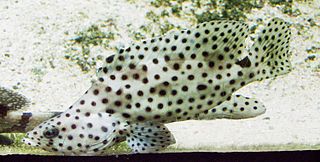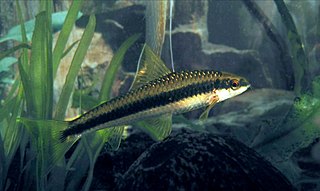
Cyprinidae is a family of freshwater fish commonly called the carp or minnow family, including the carps, the true minnows, and their relatives the barbs and barbels, among others. Cyprinidae is the largest and most diverse fish family, and the largest vertebrate animal family overall, with about 3,000 species; only 1,270 of these remain extant, divided into about 200 valid genera. Cyprinids range from about 12 mm in size to the 3 m (9.8 ft) giant barb. By genus and species count, the family makes up more than two-thirds of the ostariophysian order Cypriniformes. The family name is derived from the Greek word kyprînos.

The Serranidae are a large family of fishes belonging to the order Perciformes. The family contains about 450 species in 65 genera, including the sea basses and the groupers. Although many species are small, in some cases less than 10 cm (3.9 in), the giant grouper is one of the largest bony fishes in the world, growing to 2.7 m in length and 400 kg (880 lb) in weight. Representatives of this group live in tropical and subtropical seas worldwide.

Cypriniformes is an order of ray-finned fish, including the carps, minnows, loaches, and relatives. Cypriniformes is an Order within the Superorder Ostariophysi consisting of "Carp-like" Ostariophysins. This order contains 11-12 families, although some authorities have designated as many as 23, over 400 genera, and more than 4,250 species, with new species being described every few months or so, and new genera being recognized frequently. They are most diverse in southeastern Asia, and are entirely absent from Australia and South America. At 112 years old, the longest-lived cypriniform fish documented is the bigmouth buffalo.

Cobitidae, also known as the True loaches, is a family of Old World freshwater fish. They occur throughout Eurasia and in Morocco, and inhabit riverine ecosystems. Today, most "loaches" are placed in other families. The family includes about 260 described species. New species are being described regularly.

Phoxinus is a genus of freshwater fish in the family Leuciscidae of order Cypriniformes, and the only members of the subfamily Phoxininae, or Eurasian minnows. The type species is Phoxinus phoxinus. The other species in this genus are also commonly known as minnows. The name "minnow" was what early English fisherman used to describe "small and insignificant". The genus Phoxinus is found throughout Eurasia, and includes 21 known species. Previously, members of the North American genus Chrosomus were also believed to form part of this genus.

Puntius is a genus of small freshwater fish in the family Cyprinidae native to South Asia and Mainland Southeast Asia, as well as Taiwan.

Rasbora is a genus of fish in the family Cyprinidae. They are native to freshwater habitats in South and Southeast Asia, as well as southeast China. A single species, R. gerlachi, is only known from an old specimen that reputedly originated from Africa (Cameroon), but this locality is considered doubtful. They are small, up to 17 cm (6.7 in) long, although most species do not surpass 10 cm (4 in) and many have a dark horizontal stripe.

Anthias are members of the family Serranidae and make up the subfamily Anthiinae. The name Anthiidae is preoccupied by a subfamily of ground beetles in the family Carabidae created by Bonelli in 1813 and this grouping should be called the Anthiadinae. However, both the 5th Edition of Fishes of the World and Fishbase give the Serranid subfamily as "Anthiinae".

Barbonymus is a ray-finned fish genus in the family Cyprinidae, containing some barb species. The genus was only established in 1999, with the tinfoil barb as type species; thus, these fish are sometimes collectively called tinfoils. The new genus was established in recognition of the fact that some large Asian "barbs", formerly rather indiscriminately lumped in Barbus, Barbodes and Puntius, form a distinct evolutionary lineage.

Garra is a genus of fish in the family Cyprinidae. These fish are one example of the "log suckers", sucker-mouthed barbs and other cyprinids commonly kept in aquaria to keep down algae. The doctor fish of Anatolia and the Middle East belongs in this genus. The majority of the more than 140 species of garras are native to Asia, but about one-fifth of the species are from Africa.

Danio erythromicron, often known as emerald dwarf danio and emerald dwarf rasbora, is a species of cyprinid fish which is endemic to Inle Lake in Myanmar.

The bitterling-like cyprinids form the cyprinid subfamily Acheilognathinae. This subfamily contains four genera, although the Khanka spiny bitterling is often placed in Acheilognathus, and at least 71 described species to date. Over half of the species are in the genus Acheilognathus.

Labeoninae is a doubtfully distinct subfamily of ray-finned fishes in the family Cyprinidae of order Cypriniformes. They inhabit fresh water and the largest species richness is in the region around southern China, but there are also species elsewhere in Asia, and some members of Garra and Labeo are from Africa. They are a generally very apomorphic group, perhaps the most "advanced" of the Cyprinidae. A common name for these fishes is labeonins or labeoins.

Goodeinae is a subfamily of splitfins from Mexico, part of the family Goodeidae. They are small fish which mostly live in fresh water, especially around Mesa Central, west of Mexico City. Members of the subfamily are also found in brackish water on both the east and west coasts. They typically have small ranges and many are seriously threatened. The subfamily takes its name from its type genus Goodea and so is ultimately named after the American ichthyologist George Brown Goode (1851-1896).

Leuciscinae is a subfamily of the freshwater fish family Cyprinidae, which contains the true minnows.

Loaches are fish of the superfamily Cobitoidea. They are freshwater, benthic (bottom-dwelling) fish found in rivers and creeks throughout Eurasia and northern Africa. Loaches are among the most diverse groups of fish; the 1249 known species of Cobitoidea comprise about 107 genera divided among 9 families.

Gobioninae is a monophyletic subfamily of Eurasian cyprinid fishes. A species-rich subfamily, it is divided into five tribes: Gobionini, Pseudogobionini, Hemibarbini, Coreiini, and Sarcocheilichthyini.

Alburninae is a small subfamily of the carp and minnow family of ray-finned fish, the Cyprinidae. The genera in this subfamily were previously considered to be part of the Leuciscinae, but if the three Alburninae genera are included in that subfamily, it is paraphyletic. The Alburninae are still a contentious group and some authorities consider it to consist of two distinct clades, making it biphyletic.

Squaliobarbinae is a small subfamily of the carp and minnow family, Cyprinidae, which consists of three monotypic genera which have their natural distributions in eastern Asia. Two species, the grass carp and the black carp, have been introduced to other parts of the world for weed control and aquaculture. They are large cyprinids characterised by an enlarged subtemporal fossa, the palate articulating with the supraethmoid, an enlarged intercalar bone in the cranial vault, and a divided levator posterior muscle.



















